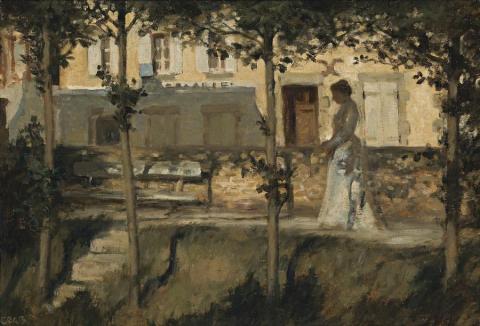CLAIRE DE LUNE, c.1900
Rupert Bunny
oil on canvas
50.0 x 73.0 cm
signed lower left: ‘CRWB’
Macquarie Galleries, Sydney
Mr & Mrs Alexis Albert, Sydney
Sotheby's, Melbourne, 28 – 29 April 1998, lot 48
Private collection, Melbourne
Exposition Rupert Bunny, Henry Graves and Co Ltd, Paris, 3 – 18 March 1905, cat. 10
Rupert Bunny: Earlier Paintings, Macquarie Galleries, Sydney, 1 – 8 October 1945, cat. 10, as 'Claire de Lune'
Earlier Paintings by Rupert Bunny, Macquarie Galleries, Sydney, 14 January – 2 February 1948, cat 1
Turnbull, C., & Buesst, T., The Art of Rupert Bunny, Ure Smith Pty Limited, Sydney 1948, p. 70
Thomas, D., Rupert Bunny, Lansdowne Press Pty Ltd, Melbourne, 1970, p. 114, cat. 042
As the old century was turning into the new, Rupert Bunny painted a number of landscapes of northern France, as well continuing his big subject pictures based on Christian and classical literary sources. The landscapes included harvests in Brittany, Breton farm scenes, the fishing fleet at Etaples, and a low tide at Brignogan. A typical example is A Breton Farm in the collection of the National Gallery of Australia, Canberra. Bunny signed it with his initials 'RCWB'. While the two most common forms of signature used by Bunny are 'Rupert C W Bunny' and 'RCWB' in monogram within a square, he did, especially in the earlier years, use other forms. His formal name was 'Charles Rupert Wulsten Bunny'. This appears on various records, including the Matriculation Roll of the University of Melbourne. Bunny, however, preferred 'Rupert' to 'Charles'. His diffidence explains the various signatures he used, especially about the turn of the century when he signed a number of landscape paintings 'RCWB', and occasionally 'CRWB', as in Claire de Lune.
Gently atmospheric and tonally darker than his later paintings, in Claire de Lune Bunny maintained an ongoing classical balance with a compositional emphasis across the picture plane. Compared with A Breton Farm, the trunks of the trees are now elegantly slender, in keeping with the romantic nature of the painting and pensive female figure. The human presence is always apparent in Bunny's work. Even the landscapes without their labouring peasants show the hand of man in the tilled fields, vineyards and clusters of buildings. While his interest in painting the female figure had early triumphs in such masterly works of about 1897 as Dolce far Niente and A Summer Morning, in the collection of the Art Gallery of South Australia, the first decade of the twentieth century saw him devoting much of his art to feminine charm within gentle, intimate settings. The inspiration was, of course, Jeanne Morel, whom Bunny married in 1902. Her ravishing beauty had him in her thrall. She was his favourite model, although in Claire de Lune the figure is perhaps of a more matronly age than Jeanne would have been at this time. The subject of claire de lune or moonlight, invokes romance that occupied Bunny. As he had a deep and abiding interest in music, it would seem likely that his painting was influenced by one of Claude Debussy's most popular pieces of the same name. Debussy wrote two settings to Paul Verlaine's poem of this title. The first was in 1892, followed in 1902 by the second. His Symbolist interests would have likewise appealed to Bunny, whose art of the 1890s reflected more than a passing interest in French Symbolism.
DAVID THOMAS
